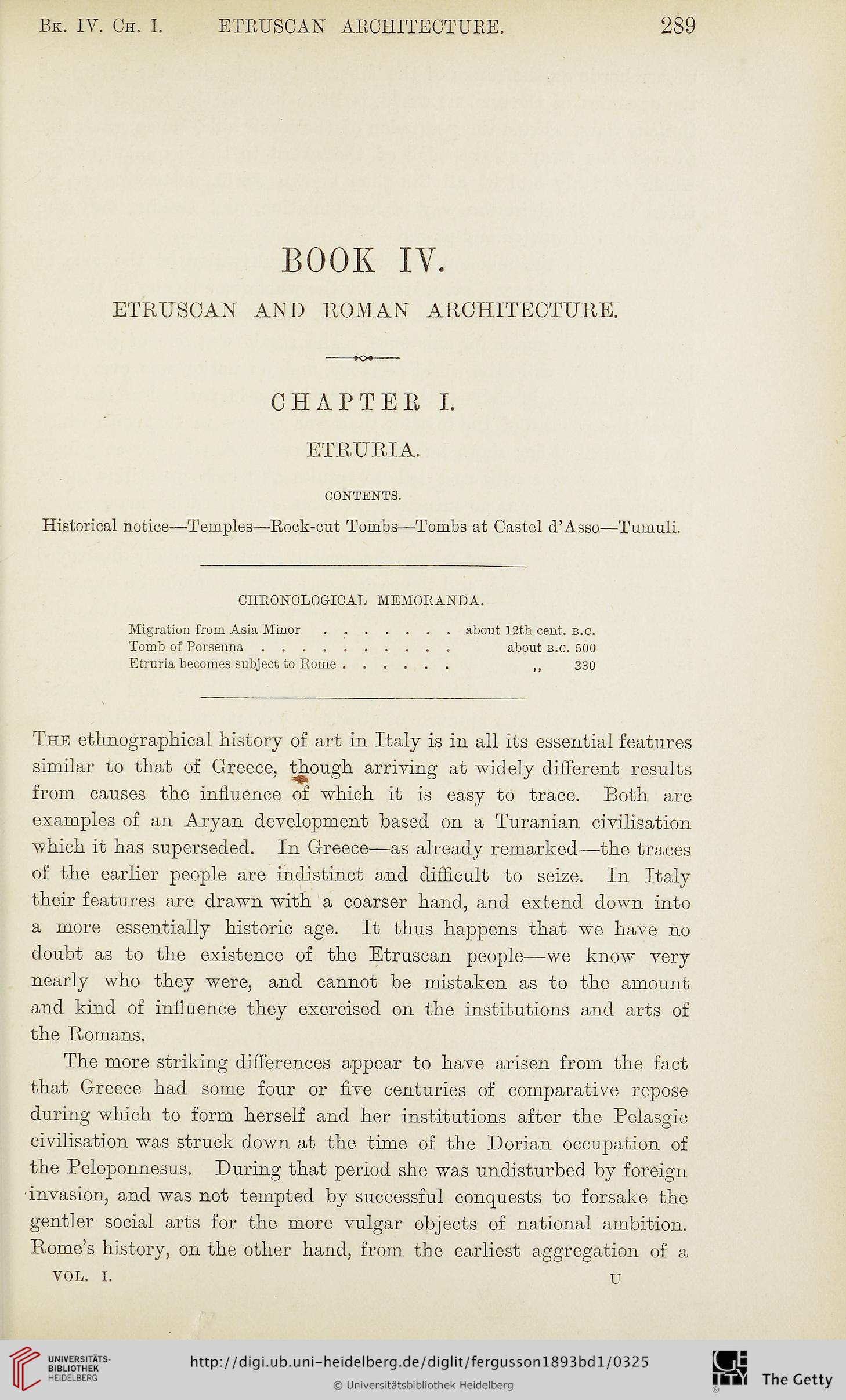Bk. IV. Ch. I.
ETRUSCAN ARCHITECTURE.
289
BOOK IY.
ETRUSCAN AND ROMAN ARCHITECTURE.
CHAPTER I.
ETRURIA.
CONTENTS.
Historical notice—Temples—Rock-cut Tombs—Tombs at Castel d’Asso—Tumuli.
CHRONOLOGICAL MEMORANDA.
Migration from Asia Minor.about 12th cent. b.c.
Tomb of Porsenna. about b.c. 500
Etruria becomes subject to Rome. ,, 330
The ethnographical history of art in Italy is in all its essential features
similar to that of Greece, though arriving at widely different results
from causes the influence of which it is easy to trace. Both are
examples of an Aryan development based on a Turanian civilisation
which it has superseded. In Greece—as already remarked—the traces
of the earlier people are indistinct and difficult to seize. In Italy
their features are drawn with a coarser hand, and extend down into
a more essentially historic age. It thus happens that we have no
doubt as to the existence of the Etruscan people—we know very
nearly who they were, and cannot be mistaken as to the amount
and kind of influence they exercised on the institutions and arts of
the Ptomans.
The more striking differences appear to have arisen from the fact
that Greece had some four or five centuries of comparative repose
during which to form herself and her institutions after the Pelasgic
civilisation was struck down at the time of the Dorian occupation of
the Peloponnesus. During that period she was undisturbed by foreign
invasion, and was not tempted by successful conquests to forsake the
gentler social arts for the more vulgar objects of national ambition.
Rome’s history, on the other hand, from the earliest aggregation of a
VOL. I.
U
ETRUSCAN ARCHITECTURE.
289
BOOK IY.
ETRUSCAN AND ROMAN ARCHITECTURE.
CHAPTER I.
ETRURIA.
CONTENTS.
Historical notice—Temples—Rock-cut Tombs—Tombs at Castel d’Asso—Tumuli.
CHRONOLOGICAL MEMORANDA.
Migration from Asia Minor.about 12th cent. b.c.
Tomb of Porsenna. about b.c. 500
Etruria becomes subject to Rome. ,, 330
The ethnographical history of art in Italy is in all its essential features
similar to that of Greece, though arriving at widely different results
from causes the influence of which it is easy to trace. Both are
examples of an Aryan development based on a Turanian civilisation
which it has superseded. In Greece—as already remarked—the traces
of the earlier people are indistinct and difficult to seize. In Italy
their features are drawn with a coarser hand, and extend down into
a more essentially historic age. It thus happens that we have no
doubt as to the existence of the Etruscan people—we know very
nearly who they were, and cannot be mistaken as to the amount
and kind of influence they exercised on the institutions and arts of
the Ptomans.
The more striking differences appear to have arisen from the fact
that Greece had some four or five centuries of comparative repose
during which to form herself and her institutions after the Pelasgic
civilisation was struck down at the time of the Dorian occupation of
the Peloponnesus. During that period she was undisturbed by foreign
invasion, and was not tempted by successful conquests to forsake the
gentler social arts for the more vulgar objects of national ambition.
Rome’s history, on the other hand, from the earliest aggregation of a
VOL. I.
U




